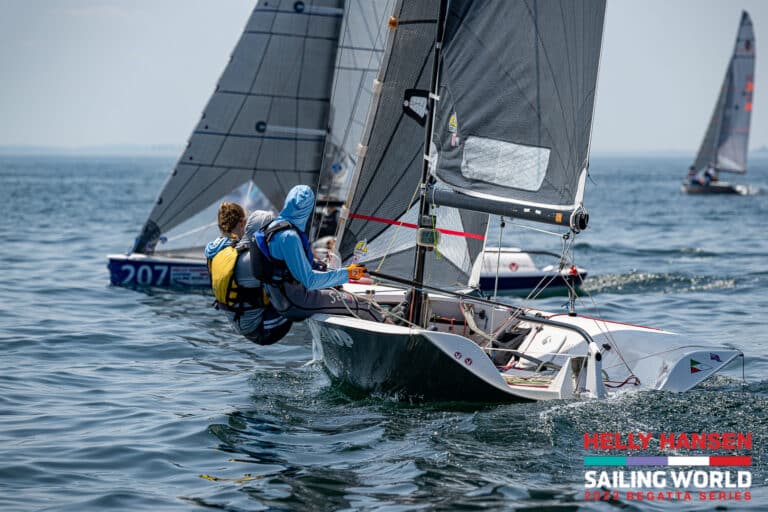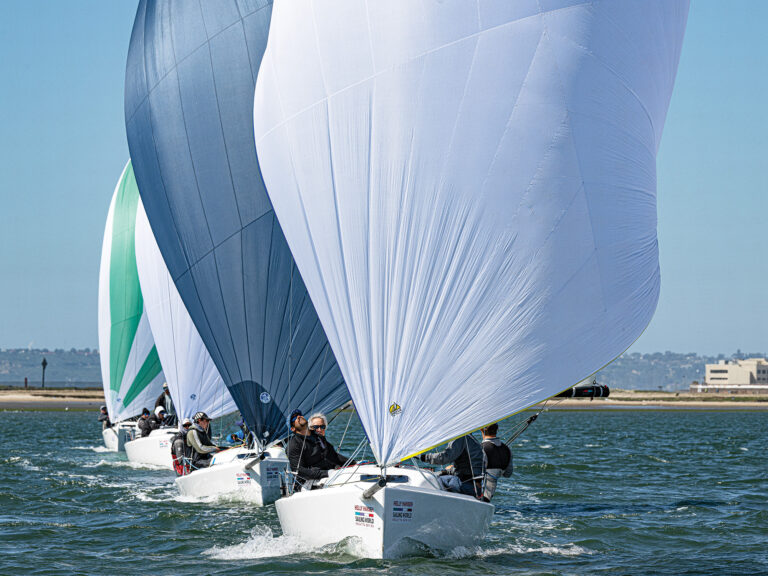Sebastien Destremau is both a journalist and a top-flight sailor. During the last America’s Cup, he was on the other side of the microphone as the tactician for China Team. Now he swaps places and interviews French designer and builder Gilles Ollier about the prospect of getting a custom 90-foot multihull ready for a Deed of Gift America’s Cup in 2008.
Sebastien Destremau: Gilles, can I ask you to first introduce yourself and your experience in designing and building maxi multihulls?
Gilles Ollier: I created Multiplast in 1981. The year Formula One cars started using the carbon fiber to build their vehicle. In 1982-’83 we built our first all carbon boat Credit Agricole. Our techniques were developed and in 1987-’88 we started using “the oven technology” and have never looked back ever since.
SD: So you have been building multihull for the last 25 years. What are the boats you have been building for the past, say, ten years?
GO: We have built several America’s Cup boats, the latest being in 2002 for the French team and some Orma 60 footers. As far as maxi multihulls are concerned, we’ve built the triplets for the Race 2000 (Club Med, etc, ) from design to construction. After these catamarans, we did Geronimo (VPLP design), Orange 2 (Ollier Design) and Groupama 3 (VPLP Design).
SD: I note that your designs are all catamarans whilst the ones from VLPLs are trimarans. Can you elaborate on that?
GO: We believe catamarans are better for offshore racing and much simpler to design and build. You’ve got to remember that the program for these multi’s is generally to sail around the World so we look for safety as well as performance. There is no doubt that a trimaran is much better suited for inshore racing or windward leeward type courses however they are trickier and take longer to build. They are also much more powerful as the ratio length/width is one for one as opposed to two for one for a cat.
SD: Trickier and longer to build?
GO: Yes. If you build a catamaran you can have one mould for both hulls and two crossbeams that can be of a similar design. Consequently you are saving a lot of time in the building process. The tri’s are trickier because you obviously have to build three moulds, and you can have all the latest development features like foils, canting mast, etc and all of these consume a lot of productivity time in order to perform. Where as on a big cats, these ‘features’ do not yet exist.
SD: How long did it take you to build some of your profile beasts?
GO: You are always pressured by external concerns like late sponsors’s decisions or last minute changes from the skippers or the design team. It took us 18 months to build Groupama 3 keeping in mind that we were not the designers (VPLP) and this tends to extend the building process.
Orange 2 was completed in 14 months. We are very proud of this achievement but we needed to employ 50 peoples to work the 100,000 hours necessary to build her.
With our track record in delivering these boats, we are very confident in our technology and process. To give you an example: We test each bucket of resin used and keep a record of it. I could give you the test results of the resin used to build Groupama 3 aft cross beam if need be. We also test each boat in the yard during one month before their sea-trial.
SD: 14 months for Orange 2?
GO: Yes, from conception to delivery. Bear in mind that three months are required to build the tools and molds. This period of time can be reduced, if you are extremely well organized and plan in advance.
Also, some parts of the construction can be outsourced but again this takes a fair bit of forward planning and project management. Outsourcing has never been easy in our business and I personally try to avoid it for quality control purposes.
SD: I believe that Team Dennis Conner built not one, but two cats in six months 20 years ago. How did he manage to do that then when it took you 14 months to build Orange 2?
GO: You are right. Firstly they were only 60 feet long and extremely simple in design. A bit like a Tornado: two hulls and two cross beams, period, done, finished. The only developments were in the sails with a soft and a rigid mainsail but these were outsourced. It is definitively not comparable with an Orange 2, Groupama or Geronimo.
SD: So if I was to provide you with a complete set of plan’s for a 90-foot by 90-foot multihull today and asked you to build my boat for the America’s Cup match. What would you say?
GO: I would be very pleased especially if money is not an issue! More seriously, I wouldn’t be ready to start building tomorrow that’s for sure! I would have to study the design, talk to your people, have meetings, and develop the tools etc before I can even consider laying the first piece of wood to build the pre form. Think about the carbon’s supply? Four to six weeks minimum for such high tech carbon. And it comes from Japan too!
So lets say that your design team is extremely well organized and they give me the best set of designs I’ve ever seen. I would hire a large group of technicians and organize them on two eight hours shifts within a 24hour period.
SD: Two shifts? Why not three and work around the clock?
GO: Three times eight hours is not an option for us. The carbon has to dry and cure from time to time!
SD: OK, two shifts. What then?
GO: It is absolutely impossible for me to build a boat like this in less than eight months. Six if I can outsource to already contracted boat builders. Eight months would be a major achievement to deliver a boat like this keeping in mind that she wouldn’t be ready to sail within this time frame.
SD: Six to eight months and she is not even ready to sail? So how long before I can have my boat ready to race then?
GO: OK you can have your boat in eight months. Sailing? Maybe add another few weeks if all goes well. Now if you are talking about racing then think twice. Your boat is not going to be race ready until several months later.
Trimarans are extremely powerful, super light and rigidity is key to performance in multihull’s. This equation is like dynamite and it is very common to have serious breakages with this kind of boat when they are first launched. Remember Groupama 3’s accident last month? Well, how long did it take for Franck and his boys to build and develop her? Years!
Let me put it this way. It is easy for me to build a nice piece of art inside eight months for you. However, it will be a boat for a show room and certainly not a boat ready to race.
After a couple of weeks of sea trials, you’ll probably loose a part of the hull, or break a mast or destroy a foil or maybe all of these altogether. This will set you back another month or two so on and so forth.
These boats are a nightmare compared to an America’s Cup boat. A Cup boat is so easy to engineer, to build; there is nothing inside them! But a 90-foot multihull built for grand-prix type racing is a completely different ball game. Especially if your boat has to be very light and has an expected life span of three to four months.
I’d love the challenge, though with all our knowledge and experience I honestly don’t see how this time frame can be reduced. We’ve been doing it for over 25 years now and I would be extremely surprised if anyone can beat me on a job like this!
SD: So what if the America’s Cup was sailed in 2008 then?
GO: You must be joking and you’ll have to find someone else to build your boat. Seriously, I don’t know where the American Team is at with their building program, but I believe they are a couple of months off from launching so their boat is not going to be anywhere near ready to sail in July 2008. October? Maybe. But they’ll have to pray they don’t have any major breakages before the event and for the wind to blow under 10 to 12 knots.
As for the Swiss, even if they start building right now, they are stuffed for 2008 anyway!
SD: So if I hear correctly, you are predicting no competitors if the Cup is in July of this year? And maybe one if it is in October 2008?
GO: Precisely. Pretty sad prospect isn’t it?
I am really looking forward to this DoG match. Can you imagine two 90-foot by 90-foot Trimarans, fitted with all the gismos, no budget constraints, sailed by the two best teams in the world, going head to head for the ultimate prize in sailing? What a race it will be! I cannot wait and the thought of watching it gives me a chill down my spine!
SD: We love your enthusiasm and you are obviously following this story very carefully. Do you have an opinion on the current situation?
GO: The legal situation? No. But I am a passionate about multihulls. According to what we’ve been told, Oracle did start building sometime late last year, good on them. They have hired VPLP design and the Groupama’s Group, good on them again.
I have to say here that I am surprised they are not using more of these Groupama guys’ experience. From what I have heard, they think they know better than the Frenchies and some of our compatriots are frustrated.
Well, let me assure you of one thing, in my opinion the French people are the best in this business and with their experience accumulated over 20 to 30 years of maxi multihulls, their 90-foot rimaran would be out of this world. But then again who am I to say this? just another Frenchman!
SD: Before we go, as a Frenchman and one of the World’s most qualified multihull designer/builder, is there anything you would like to add?
GO: My closing comment would be the following assumption:
• If the Cup is to be sailed in October 2008 and Oracle doesn’t suffer any set back in their preparation, it will be a no contest.
• It will also be a no contest if the Cup is sailed in July 2008. Neither competitor can make it to the start line, in my opinion. Unless Alinghi can come up with a suitable boat and sail alone around the racecourse.
• Even if the Cup is in mid-2009 it will be a mammoth task for both teams to be race ready.
• If the goal is to win the Cup at all costs, so be it. But for the sanctity of the sport, the later the event the better!
SD: Thank you for your time Gilles, it’s been a pleasure talking to you.









